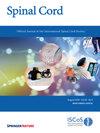Associations between personality traits and depressive and anxiety symptoms among persons with spinal cord injury in first inpatient rehabilitation
IF 2.1
4区 医学
Q3 CLINICAL NEUROLOGY
引用次数: 0
Abstract
Retrospective analysis of medical records. To assess personality traits in persons with spinal cord injury (SCI) and compare these with the general population group. Moreover, to explore associations between personality traits and depressive and anxiety symptoms among persons with SCI in first inpatient rehabilitation. Specialized rehabilitation center in The Netherlands. Data were used from a routine psychological screening, administered in the first weeks of admission (N = 67). Measures included the Hospital Anxiety and Depression Scale and the Dutch Personality Questionnaire, which includes subscales measuring neuroticism, social inadequacy, rigidity, hostility, egoism, dominance, and self-esteem. Correlational and regression analyses were conducted. Mean age of the participants was 58 (SD 17) years. The majority (63%) were male, and had a low lesion (57%). The participants scored significantly higher on dominance and lower on social inadequacy, hostility, and egoism in comparison with the general population. In the bivariate regression analyses, high neuroticism (β = 0.42 and β = 0.53) and low self-esteem (β = -0.25 and β = -0.29) were significantly associated with increased depressive and anxiety symptoms. In the hierarchical regression analyses, only high neuroticism was significantly associated with increased depressive (β = 0.42, p < 0.05) and anxiety (β = 0.55, p < 0.001) symptoms. Personality traits are not the same between the SCI population and the general population. Assessment of personality traits early in inpatient rehabilitation can help to identify individuals at risk of mood problems and, thereby, facilitate interventions. Future research with a larger, representative SCI sample, is required to confirm these findings.首次住院康复的脊髓损伤患者的人格特质与抑郁和焦虑症状之间的关系。
研究设计对医疗记录进行回顾性分析:评估脊髓损伤(SCI)患者的人格特质,并与普通人群进行比较。此外,探讨首次住院康复的脊髓损伤患者的人格特质与抑郁和焦虑症状之间的关联:环境:荷兰的专业康复中心:方法:数据来自入院头几周的常规心理筛查(67人)。测量方法包括医院焦虑和抑郁量表以及荷兰人格问卷,其中包括测量神经质、社交不足、刻板、敌意、自我主义、支配欲和自尊的子量表。研究还进行了相关分析和回归分析:参与者的平均年龄为 58 岁(SD 17)。大多数(63%)为男性,病变程度较低(57%)。与普通人相比,参与者在支配欲方面的得分明显较高,而在社交不足、敌意和利己主义方面的得分较低。在二元回归分析中,高神经质(β = 0.42 和 β = 0.53)和低自尊(β = -0.25 和 β = -0.29)与抑郁症状和焦虑症状的增加明显相关。在分层回归分析中,只有高神经质与抑郁症状的增加有明显相关性(β = 0.42,p 结论):SCI 患者的人格特质与普通人群并不相同。在住院康复早期对人格特质进行评估有助于识别情绪问题的高危人群,从而促进干预措施的实施。未来需要对更多具有代表性的 SCI 样本进行研究,以证实这些发现。
本文章由计算机程序翻译,如有差异,请以英文原文为准。
求助全文
约1分钟内获得全文
求助全文
来源期刊

Spinal cord
医学-临床神经学
CiteScore
4.50
自引率
9.10%
发文量
142
审稿时长
2 months
期刊介绍:
Spinal Cord is a specialised, international journal that has been publishing spinal cord related manuscripts since 1963. It appears monthly, online and in print, and accepts contributions on spinal cord anatomy, physiology, management of injury and disease, and the quality of life and life circumstances of people with a spinal cord injury. Spinal Cord is multi-disciplinary and publishes contributions across the entire spectrum of research ranging from basic science to applied clinical research. It focuses on high quality original research, systematic reviews and narrative reviews.
Spinal Cord''s sister journal Spinal Cord Series and Cases: Clinical Management in Spinal Cord Disorders publishes high quality case reports, small case series, pilot and retrospective studies perspectives, Pulse survey articles, Point-couterpoint articles, correspondences and book reviews. It specialises in material that addresses all aspects of life for persons with spinal cord injuries or disorders. For more information, please see the aims and scope of Spinal Cord Series and Cases.
 求助内容:
求助内容: 应助结果提醒方式:
应助结果提醒方式:


